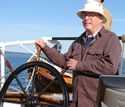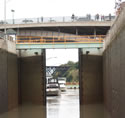

Traveling In The Past Lane

Text
and Photos by Sandra Scott
Put excitement into learning about American history by living it. Sail on a windjammer to experience coming to America. Feel the tension of the impending American Revolution at Colonial Williamsburg. Head west on the Eire Canal and continue on the Santa Fe Trail. Enlist in the Civil War in Pamplin, VA. Walk in the shoes of the everyday people who built America, sleep as they did, and see America as they did.
Coming to America
 Millions of immigrants came to America by ship, some on windjammers like
the Grace Bailey. The Grace Bailey was completely restored in 1990 and
is now a National Historic Landmark. It is just one of the tall-mast schooners
where people can experience life on board and learn the meaning of “close
quarters.” After the first full day aboard ship passengers get their
bearings and settle into a comfortable routine. With the clanging of pots
and pans in the galley and the smell of coffee the day begins. All hands
help raise the sails by following the commands, “Ready on the Throat.
Ready on the Peak. Haul Away. Two-six heave. Two steps toward me. Drop
the line.” On a foggy morning take turns blowing the conch shell
– the early foghorn – until the sun breaks through. The crew
turns young “immigrants” into sailors with lessons in seamanship.
For the lucky the skies were blue and seas calm providing a pleasant respite
before carving out a new life in a new country.
Millions of immigrants came to America by ship, some on windjammers like
the Grace Bailey. The Grace Bailey was completely restored in 1990 and
is now a National Historic Landmark. It is just one of the tall-mast schooners
where people can experience life on board and learn the meaning of “close
quarters.” After the first full day aboard ship passengers get their
bearings and settle into a comfortable routine. With the clanging of pots
and pans in the galley and the smell of coffee the day begins. All hands
help raise the sails by following the commands, “Ready on the Throat.
Ready on the Peak. Haul Away. Two-six heave. Two steps toward me. Drop
the line.” On a foggy morning take turns blowing the conch shell
– the early foghorn – until the sun breaks through. The crew
turns young “immigrants” into sailors with lessons in seamanship.
For the lucky the skies were blue and seas calm providing a pleasant respite
before carving out a new life in a new country.
Colonial life
 Colonists
living in Williamsburg, Virginia Colony, found the sound of the fife and
drum band marching down Duke of Gloucester Street too stirring to resist
and so will those who stay in one of the authentic 18th century colonial
houses that line Colonial Williamsburg’s main street. Get into the
spirit by donning colonial clothing and head to the capitol steps to listen
to the reading of the Declaration of Independence. Join in the heated
discussions about the impending war with preachers, house servants, farmers,
and artisans—both enslaved and free. The latest colonial news was
found at Christiana’s Tavern. Christiana, like all tavern owners,
is a font of knowledge. “Washington has stayed with us 96 times.
He steps a fine minuet, you know. All the ladies want to dance with him.”
She continues with,
Colonists
living in Williamsburg, Virginia Colony, found the sound of the fife and
drum band marching down Duke of Gloucester Street too stirring to resist
and so will those who stay in one of the authentic 18th century colonial
houses that line Colonial Williamsburg’s main street. Get into the
spirit by donning colonial clothing and head to the capitol steps to listen
to the reading of the Declaration of Independence. Join in the heated
discussions about the impending war with preachers, house servants, farmers,
and artisans—both enslaved and free. The latest colonial news was
found at Christiana’s Tavern. Christiana, like all tavern owners,
is a font of knowledge. “Washington has stayed with us 96 times.
He steps a fine minuet, you know. All the ladies want to dance with him.”
She continues with,  “Up
Boston way they dumped tea into the harbor so many of us are drinking
coffee now.” Help with chores at Great Hopes Farm. Dance at the
Governor’s Ball or sit on the jury at the trail of Grace Sherwood,
Virginia’s Witch. Youngsters can learn a trade in Williamsburg’s
apprentice program. End the day at Chowing’s Tavern for gambols
- games and songs that were popular in 18th century taverns.
“Up
Boston way they dumped tea into the harbor so many of us are drinking
coffee now.” Help with chores at Great Hopes Farm. Dance at the
Governor’s Ball or sit on the jury at the trail of Grace Sherwood,
Virginia’s Witch. Youngsters can learn a trade in Williamsburg’s
apprentice program. End the day at Chowing’s Tavern for gambols
- games and songs that were popular in 18th century taverns.
Heading west
 Following
the Revolutionary War the United States expanded from sea to shining sea.
Board a packet boat on the Erie Canal for the trip to Buffalo. Today the
canal is a quiet, tranquil waterway making it hard to envision the 1830s
when the bustling Erie Canal was the fastest and easiest way to travel.
While the boats are no longer pulled by mules the speed limit remains
five miles an hour. “Low Bridge, Everyone down” is still an
appropriate cry because several canal communities have lift-bridges. The
boat
Following
the Revolutionary War the United States expanded from sea to shining sea.
Board a packet boat on the Erie Canal for the trip to Buffalo. Today the
canal is a quiet, tranquil waterway making it hard to envision the 1830s
when the bustling Erie Canal was the fastest and easiest way to travel.
While the boats are no longer pulled by mules the speed limit remains
five miles an hour. “Low Bridge, Everyone down” is still an
appropriate cry because several canal communities have lift-bridges. The
boat  captain
radios, “Seneca calling Middleport Bridge, requesting westbound
passage.” A railroad-style gate stops road traffic and the bridge
is raised. Locking through the historic locks in Lockport is a hands-on
lesson in canalling. When the massive water gates open the captain eases
the boat into the lock. The water gate is closed, the water pumped out,
and in five minutes the boat is 25 feet higher. Several towns, including
Lockport, have museums preserving Erie Canal history.
captain
radios, “Seneca calling Middleport Bridge, requesting westbound
passage.” A railroad-style gate stops road traffic and the bridge
is raised. Locking through the historic locks in Lockport is a hands-on
lesson in canalling. When the massive water gates open the captain eases
the boat into the lock. The water gate is closed, the water pumped out,
and in five minutes the boat is 25 feet higher. Several towns, including
Lockport, have museums preserving Erie Canal history.
On the trail
 From the 1821 to 1880, the Santa Fe Trail was one of the “big three”
American trails, along with the Oregon and Chisholm Trails. Today several
companies offer covered wagon experiences on the trail. Wake to the yipping
of coyote pups and the smell of coffee brewing over an open fire. Follow
the directions of the trail master, “When you get into the wagon,
step quickly. Sometimes the horses jerk the wagon forward causing you
to fall.” And, “Don’t worry about snakes, the vibration
of the wagon wheels usually scares them away.” It doesn’t
take long to feel the rhythm of the trail. The scenery is breathtaking.
Part of the trail goes through the tall
From the 1821 to 1880, the Santa Fe Trail was one of the “big three”
American trails, along with the Oregon and Chisholm Trails. Today several
companies offer covered wagon experiences on the trail. Wake to the yipping
of coyote pups and the smell of coffee brewing over an open fire. Follow
the directions of the trail master, “When you get into the wagon,
step quickly. Sometimes the horses jerk the wagon forward causing you
to fall.” And, “Don’t worry about snakes, the vibration
of the wagon wheels usually scares them away.” It doesn’t
take long to feel the rhythm of the trail. The scenery is breathtaking.
Part of the trail goes through the tall  grass
prairie of Kansas where there is not a bulding in sight, only wide-open
grassland.
grass
prairie of Kansas where there is not a bulding in sight, only wide-open
grassland.
In the evening, the womenfolk prepare dinner – stew, biscuits,
and cobbler – on the open fire while the men take care of the horses.
When all the camp chores are done, it is time for storytelling and singing
“Out on the Lone Prairie” and “Along the Santa Fe Trail.”
A nation divided
 When
America’s most devastating war started in April 1861, men were quick
to join the military. Today people can sign up at Civil War Adventure
Camp in Pamplin Historical Park, VA. After being sworn in, uniforms and
equipment are issued then the drilling starts. “Platoon Assemble,”
barks the First Sergeant. “A sorry looking bunch of fresh fish.”
First Sergeant proceeds to make the unit presentable and then teaches
the commands: “Form columns of companies!” “Count off!”
“Dress right!” “Right face!” “Right Flank!”
and “March, One, Two!” Guns are issued and the new troops
learn how to “Load in Nine Times.” After a meal that includes
hardtack the
When
America’s most devastating war started in April 1861, men were quick
to join the military. Today people can sign up at Civil War Adventure
Camp in Pamplin Historical Park, VA. After being sworn in, uniforms and
equipment are issued then the drilling starts. “Platoon Assemble,”
barks the First Sergeant. “A sorry looking bunch of fresh fish.”
First Sergeant proceeds to make the unit presentable and then teaches
the commands: “Form columns of companies!” “Count off!”
“Dress right!” “Right face!” “Right Flank!”
and “March, One, Two!” Guns are issued and the new troops
learn how to “Load in Nine Times.” After a meal that includes
hardtack the  day
ends with a spell of guard duty. The morning tattoo sounds at 5:45, marching
rations are issued then it is off to a mock battle. “Fire!”
“Watch your left flank.” After the battle some of the “wounded”
were treated in the field. Other soldiers were brought to the surgery
where a few had their limbs “amputated.” When soldiers are
mustered out after the two-day experience there is a deeper appreciation
for all the people who have served in the military.
day
ends with a spell of guard duty. The morning tattoo sounds at 5:45, marching
rations are issued then it is off to a mock battle. “Fire!”
“Watch your left flank.” After the battle some of the “wounded”
were treated in the field. Other soldiers were brought to the surgery
where a few had their limbs “amputated.” When soldiers are
mustered out after the two-day experience there is a deeper appreciation
for all the people who have served in the military.
On the range
Ranching and cowboys are synonymous with the American West. The Moore
Ranch in Kansas and the Rocking Bar A in Utah are just two of many ranches
that offer authentic ranch experiences including taking tenderfoots on
a cattle drive.
Learn about the defining historical periods in American History by living life in the past lane – if only for a few days. The experiences are perfect family and multi-generation trips.
For more information check: www.mainewindjammercruises.com,
800-736-7981; www.history.org, 800-HISTORY;
www.midlakesnav.com, 800-545-4318;
www.kscoveredwagon.com, (316)
283-2636, www.pamplinpark.org,
877-PAMPLIN, www.longhorn-cattle.com,
and the www.rockinacattledrive.com.
Search the Web for related information on US History
Home | North
America | South & Central America | Europe
Asia & Middle East | Africa
| Oceania | Favorite
Accommodations
Travel Images Blog
| Preferred
Accommodations Blog
Travel Blog | Columns
| About Sandra | Contact
Sandra | Site Map
Copyright
© 2002-2007 Sandra Scott. ALL RIGHTS RESERVED
Site
designed and created by C.F. Howley